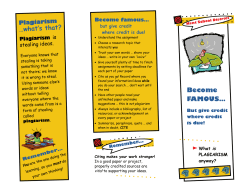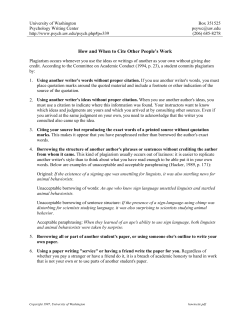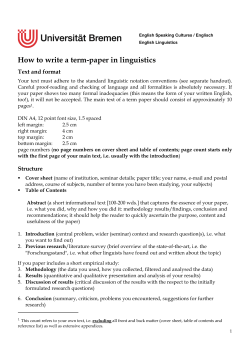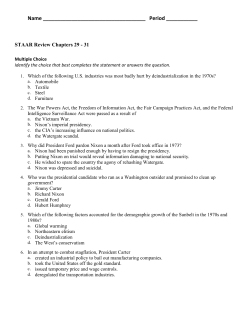
Plagiarism and Turnitin
Plagiarism and Turnitin
Resources:
English Language Teaching Centre
• http://www.shef.ac.uk/eltc/services
What is plagiarism?
• Plagiarism is “passing off others’ work
as your own, whether intentionally or
unintentionally, to your benefit. The
work can include ideas, compositions,
designs, images, computer code, and,
of course, words”.
Why is it important?
• “Any attempt by a student to gain unfair
advantage over another student in the
completion of an assessment, or to assist
someone else to gain an unfair advantage, is
cheating. Cheating undermines the standards
of the University’s awards and disadvantages
those students who have attempted to
complete assessments honestly and fairly. It is
an offence against the values of the academic
community of which students and staff are
both part………“
Tackling Plagiarism
• Detection {Ongoing} • Prevention {Preferred}
– Looking out for
– Teaching everyone what
changes in style
plagiarism is
– “Googling” a student’s
– Ensuring all students complete a
suspect phrases
formative assignment
– Using Plagiarism
• Remedial {Time-consuming}
Detection Software
– Disciplinary procedures/possible
expulsion
– Resubmission of work
So what is unacceptable and what
is acceptable?
Some Bad and Good Examples
Original, from Severin and
Tankard (1992)
There is evidence to suggest that newsmakers are becoming
particularly savvy about placing items on the media
agenda. When for example, President Reagan was running
for his second term, he took a tour to promote his
administration’s record on environmentalism. The tour was
full of photo opportunities, including the president
standing on a fishing boat in the Chesapeake Bay and the
president wearing a park ranger’s hat at Mammoth Cave,
Kentucky. Even though some thought that the Reagan
administration had a terrible record on the environment,
many people were likely to see photos of the president in
the ranger hat and make a positive link between Reagan
and the environment.
……and the source is:
Severin W, Tankard J (1992) Communication
Theories: Origins, Methods, and Uses of the
Mass Media.
New York: Longman (3rd edition)
Acceptable Practice ? - Attempt 1
• Evidence suggests that newsmakers are becoming
particularly savvy about placing items on the media
agenda. When President Reagan was running for his
second term, he took a tour to promote his administration’s
record on environmentalism. The tour was full of photo
opportunities, including the president standing on a fishing
boat in the Chesapeake Bay and the president wearing a
park ranger’s hat at a cave in Kentucky. Even though some
thought that the Reagan administration had a miserable
record on the environment, many people were likely to see
photos of the president in the ranger hat and make a
positive link between Reagan and the environment.
Acceptable Practice ? Attempt 2
• Evidence suggests that newsmakers are becoming
particularly savvy about placing items on the media
agenda. When President Reagan was running for his
second term, he took a tour to promote his administration’s
record on environmentalism. The tour was full of photo
opportunities, including the president standing on a fishing
boat in the Chesapeake Bay and the president wearing a
park ranger’s hat at a cave in Kentucky. Even though some
thought that the Reagan administration had a miserable
record on the environment, many people were likely to see
photos of the president in the ranger hat and make a
positive link between Reagan and the environment.
(Severin & Tankard, 1992, p. 256).
Acceptable Practice ? - Attempt 3
• Severin and Tankard (1992) noted President
Reagan’s apparent hypocrisy when he ran
for re-election in 1996. By posing for a
photo opportunity in a boat on the
Chesapeake Bay, Reagan, according to
these authors, possibly used the appearance
of concern to mislead voters about his
actual record on the environment.
Acceptable Practice ? - Attempt 4
Severin and Tankard (1992) noted President Reagan’s
apparent hypocrisy when he ran for re-election in 1996.
They record that:
“The tour was full of photo opportunities, including the president
standing on a fishing boat in the Chesapeake Bay and the
president wearing a park ranger’s hat at a cave in Kentucky”.
(p. 256)
They went on to comment that:
“….many people were likely to see photos of the president in the
ranger hat and make a positive link between Reagan and the
environment”. (p.256)
So what are you going to do
about it?
• Familiarise yourself with good citation practice
(e.g. ALWAYS reference sources of words or
ideas)
• Don’t cut and paste (try reading text and then
paraphrase in your own words to make notes with
screen minimised) –ALWAYS include a
reference!
• Follow guidelines in your Student Handbooks and
in the study skills module provided
So what are we going to do about
it?
• Every Student in ScHARR must complete a
plagiarism study skills module
• Every Student will be expected to submit
an 800-word assignment to special
software for plagiarism checking
• Every course tutor/coordinator will expect
you to have completed this plagiarism task
before marking your first assignment
Penalties for plagiarism
• We will hear “your side” and consider
degree of plagiarism; intent to deceive;
whether it is recurrent.
• Penalties vary from “advice,” through
requiring you to re-submit the work up to a
formal disciplinary hearing
• The ultimate penalty is expulsion from the
University
Complete one-off Registration
Scroll down for passwords and security question
Class ID:
18895
Password (case sensitive): pare1510
Password and U-card procedure
• Six – 12 characters long; Alphanumeric – at least
1 number
• When asked DON’T Enter Your Name – enter
your Ucard number followed by course
e.g.
your first name: 1459328
your last name: Psychotherapy Studies
(Preserves anonymity)
Submitting your work
You will initially have one class: ScHARR Students.
.
Viewing your work
• Log in as above
• Open the classroom
Reports
If icon is
Blue – less than 20
matching words
Green – 0 - 24%
Yellow – 25 – 49%
Orange - 50 – 70%
Red – 75 – 100%
matching text
Finally print out your
report
Remember!
• 24% or below is our test threshold. This means
you have to receive either a Blue report or a
Green report
• If you get more than 24% (Yellow, Orange or
Red) you will have to resubmit, again and again
until you get it right.
• You should “Include quotes” and “Include
bibliography” within this generous threshold.
What you need to do
• Work through the Study Skills Module
• Complete Test Assignment (12th November 2010
is the target date)
• Submit it to http://www.submit.ac.uk
• Wait for Originality Report
• Print out Originality Report, and Sign
Plagiarism Declaration Form
• Submit Report, and declaration to Course
Administrator for your student records.
© Copyright 2025















